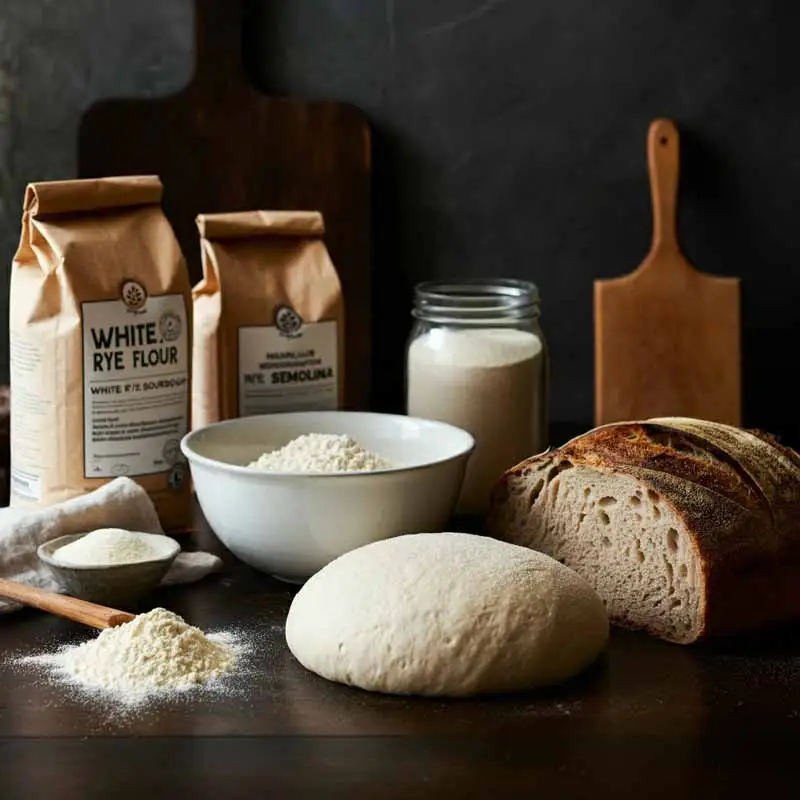Sourdough baking invites experimentation and creativity, whether you’re a seasoned baker or just starting out. You might have wondered, “Can I add semolina flour to my white rye sourdough recipe?” The answer isn’t straightforward—it depends on your goals for the bread. In this article, we explore the benefits, challenges, and methods for incorporating semolina flour into your white rye sourdough.
Understanding Semolina Flour
Semolina flour comes from durum wheat and is known for its coarse texture and high protein content, which aids in gluten development. Bakers often use semolina in pasta-making, but it can also enhance baked goods with a slightly sweet, nutty flavor. King Arthur Baking describes semolina as an ingredient that complements the earthiness of rye flour.
White Rye Sourdough: The Basics
White rye flour, milled from the endosperm of the rye grain, offers a lighter and milder flavor compared to whole rye. It retains the characteristic rye flavors while creating a tender crumb. By adding semolina flour to white rye sourdough, you can experiment with adjusting the texture and flavor of your bread.
Why Add Semolina Flour?
Adding semolina to white rye sourdough enhances the bread’s texture, giving it a more robust structure and a beautiful golden hue. The additional gluten from the semolina improves the dough’s elasticity, making it easier to handle. Moreover, the nutty notes of semolina add complexity to your sourdough, resulting in a more enjoyable loaf. If you’re curious about the nuances of rye flour, The Rye Baker offers valuable insights.
How to Incorporate Semolina Flour
Start by substituting 10-20% of your white rye flour with semolina flour. This ratio allows the semolina’s qualities to shine without overpowering the rye. Here’s a simple guide for incorporating semolina into your sourdough recipe:
- Mixing: Combine semolina and white rye flour during the initial mixing stage. Slightly adjust your water content, as semolina tends to absorb more water.
- Fermentation: Keep an eye on your dough during bulk fermentation; semolina might speed up the process due to its gluten content.
- Shaping and Proofing: Expect the dough to feel firmer and easier to shape. Proof as usual.
If you’re interested in other ways to use flour, the article on sourdough discard recipes is a great resource.
Challenges to Consider
While adding semolina flour offers benefits, it can also present challenges. Using too much semolina might toughen the dough, and the crumb can become denser than a typical white rye sourdough. If your first attempt isn’t perfect, don’t be discouraged. Adjust the hydration or the percentage of semolina until you find the right balance.
Taste and Texture: What to Expect
With semolina, you can expect a bread with a slightly more open crumb than pure rye sourdough. The flavor will blend rye’s earthiness with semolina’s subtle sweetness, making it perfect for pairing with savory spreads or toppings.
Frequently Asked Questions
Can I use whole rye instead of white rye?
Yes, but you will get a more robust flavor and denser texture.
What percentage of semolina should I start with?
Start with 10-20% of your total flour weight.
Will semolina affect the sourness of my sourdough?
Semolina might slightly mellow the sourness due to its lower acidity compared to rye.
Can I substitute semolina with other flours?
Yes, other high-gluten flours like bread flour can replace semolina, but the flavor and texture will differ.
For more ideas on using your sourdough starter, visit this article on sourdough discard.
Conclusion
Adding semolina flour to your white rye sourdough recipe is a great way to experiment with flavors and textures. Start small, observe the changes, and adjust as needed. With each bake, you’ll refine your technique and create a bread that’s uniquely yours.
